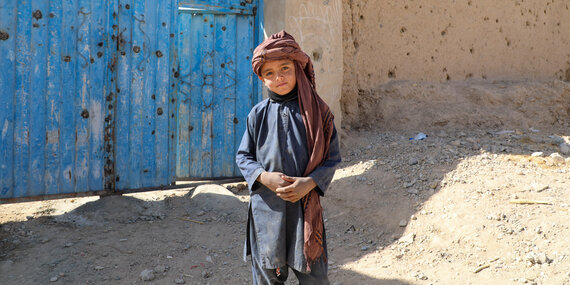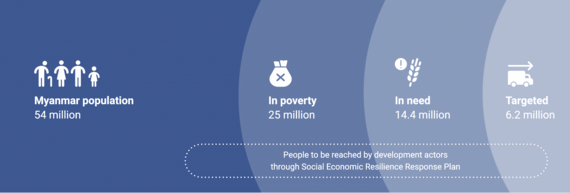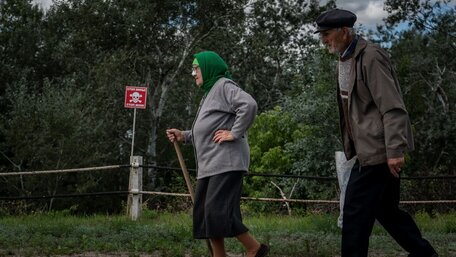Fasl-e-Bolan, Afghanistan
A 7-year-old boy in Fasl-e-Bolan, Hilmand Province. When asked if he goes to school, he replied: "How can I go to school? It burned during the fighting." OCHA/Pierre Peron
Across the Asia and the Pacific region, humanitarian needs and vulnerabilities are increasing. The impacts of climate change, protracted crises, and the health and economic shocks of COVID-19 continue to take a heavy toll on the world’s most populated region. COVID-19 has exacerbated humanitarian need in the region, and even countries with fewer reported cases have still experienced severe impacts on livelihoods, household income, poverty and food security. In many countries, the pandemic has also further constrained access to medical care for maternal and child health care, and increased the risk of child-protection issues in addition to sexual and gender-based violence.
Humanitarian Response Plans
The Delta variant dealt a major blow to many countries that initially fared well against COVID-19 in 2020. Countries struggled to maintain pandemic controls, resulting in massive death totals in the region during 2021 and in social-economic shocks in a number of countries, further exacerbating poverty rates and the vulnerabilities of people and communities. As many parts of the world reopened following a rise in vaccination rates, much of Asia and the Pacific remained under strict lockdown measures, curtailing domestic and international trade and travel, and access to countries including for disaster response.
Asia and the Pacific is home to one quarter of the world’s conflicts and several protracted crises. Displacement and violence drive humanitarian needs across the region, which has 4.4 million refugees and the world’s largest refugee settlement, in the Cox’s Bazar District of Bangladesh. The region also hosts over 3.7 million Internally Displaced People (IDPs).
Conflicts in Asia and the Pacific have typically been localized, leading to millions of people in protracted crisis settings requiring humanitarian assistance and protection, but with limited cross-border impacts. However, this changed in 2021 following a rapid deterioration of the crises in Afghanistan and Myanmar. The humanitarian needs in each country were severely impacted, with the potential for repercussions across the region as civilians seek to flee conflict and instability.
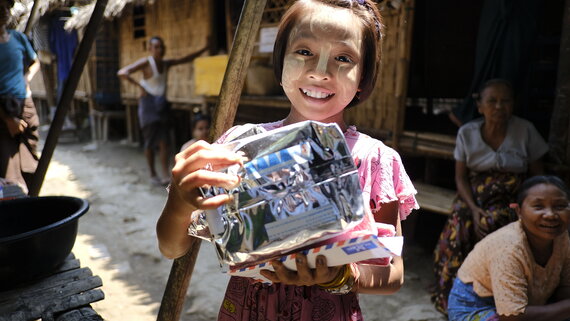
Mrauk-U Township, Myanmar
A girl from an IDP site in Rakhine State receives relief assistance from WFP.
WFPSome 77 per cent of the world’s disaster-affected people live in the Asia and the Pacific region. From 2015 to 2019, disasters affected 700 million people across the region, resulting in 44,000 deaths, 3.5 million people losing their homes, and damaged totalling US$286 billion. In 2020, 69 per cent of the global population newly displaced by disasters lived in Asia and the Pacific region. This includes some 4.4 million people temporarily displaced in the Philippines due to natural disasters. This is the world’s second-highest number, after China. In Indonesia alone, disasters directly affected over 5 million peoples in 2020, and some 148 million people live in hazard- and disaster-prone areas.
As a result of climate change, heatwaves, droughts, floods and tropical cyclones are becoming increasingly frequent and intense. The region’s dependence on natural resources and agricultural sectors, its densely populated coastal areas and its high rates of poverty make it the world’s most vulnerable area to the impact of climate change. The Pandemic and its socioeconomic and humanitarian impacts have increased people’s vulnerability to the effects of natural disasters, as coping capacities have been eroded and people have experienced multiple compound disasters.
Asia and the Pacific (2018-2022)
Asia and the Pacific: Appeals for 2022
Projected situation in 2022 and beyond
COVID-19 and its impacts will continue into 2022 due to unequal vaccination rates and the emergence of new variants. This will create far-reaching public health consequences, and vulnerable communities will require more immediate, life-saving assistance. Escalating conflict and the pandemic could also bring waves of cross-border migration and internal displacement.
Many countries will likely face multiple, compound disasters in 2022, eroding coping capacities and raising the possibility that more people will require humanitarian assistance. Afghanistan, DPR Korea and Myanmar are facing acute food insecurity situations, which are likely to deteriorate further by the year’s end.
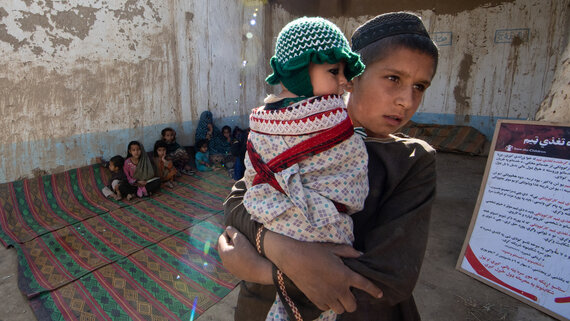
Zheray district, Afghanistan
A young boy and his baby sister wait outside a mobile clinic, where nutrition assistance is being provided.
OCHA/Charlotte CansIn Pakistan increasing inflation rates compounded by recent flooding, droughts, locust outbreaks and loss of livelihoods due to COVID-19, has caused food insecurity for 3.8 million people. Countries including Bangladesh, Cambodia, Nepal, and Sri Lanka are also at risk of increased food insecurity, partly due to climatic shocks and socioeconomic challenges. A number of countries including Papua New Guinea and Timor-Leste, have been identified as being at high risk of La Niña which, depending on the country, could bring higher or lower than average rainfall, raising the risk of flooding, drought and exacerbating food insecurity. These challenges risk eroding the coping capacities of the most vulnerable segments of the population, increasing their chances of requiring life-saving humanitarian assistance and the need for timely or even anticipatory humanitarian action.
The region also remains highly vulnerable to large-scale disasters, such as earthquakes and tsunamis, that would overwhelm the capacities and resources of in-country partners and require international humanitarian assistance.
Afghanistan
Analysis of the context, crisis and needs
The combination of conflict, drought, COVID-19, political turmoil and recurrent economic shocks had a devastating impact on the people of Afghanistan. Ruptures in basic services, financial systems and civil service are exacerbating an already dire humanitarian situation.
A staggering 22.8 million people, or 55 per cent of the population, are expected to be in crisis or emergency levels of food insecurity (IPC 3+), a nearly 35 per cent increase from the same period last year. Some 9 million people are projected to be in IPC 4 – the highest number in the world. More than half of all children under 5 years of age are now expected to be acutely malnourished in 2022, a 21 per cent increase since the start of 2021. Twenty-seven out of 34 provinces are seeing acute malnutrition rising above emergency thresholds.
In rural areas, needs are largely driven by drought – the worst of its kind in 27 years – and the cumulative effects of over four decades of conflict. Even after the harvest, 57 per cent of households did not have food reserves that would last for three months. In urban areas, severe economic shocks and resulting income loss have contributed to the rapid deterioration in people’s food security and livelihoods status. Ten out of 11 most densely populated urban areas are anticipated to be in IPC 4. In 2021, all population groups had a negative net income.
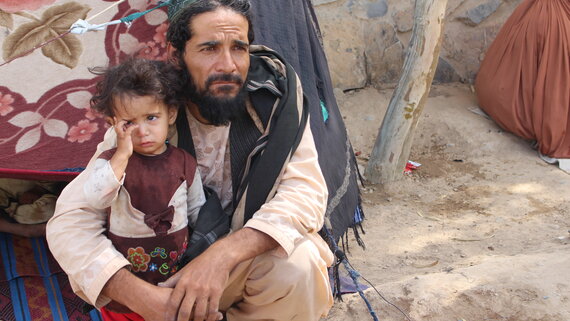
Kandahar, Afghanistan
This unemployed father and his daughter were displaced to Kandahar from their hometown due to conflict and war. They now reside in Haji camp, where they do not have a decent home. In recent months the conflict has intensified and spread. The operating space for humanitarians providing life-saving assistance continues to shrink dramatically.
UNICEF/Naqeeb IsahaqDespite the prevalence of more deadly variants of COVID-19 and outbreaks of cholera, 66 per cent of the population reported not having enough water for handwashing. Conflict and COVID-19 have also interrupted schooling for more than 9.3 million children since 2020. Threats to civilians and acute protection needs remain high, and there are grave concerns about the rollback on women’s rights and restrictions on their participation in life and society. Densely populated areas are also contaminated with explosives, putting more people, particularly those trying to return, at risk of death and maiming. Afghanistan already has one of the world’s highest per capita populations of people with disabilities, with 79 per cent of adults and 17 per cent of children believed to live with some form of disability.
Projected situation in 2022 and beyond
An estimated 24.4 million people – 59 per cent of the population – will need humanitarian and protection assistance in 2022. This is largely driven by spiraling food insecurity, dangerous levels of malnutrition, eroded livelihood opportunities, as well as conflict-driven displacement and complex protection needs. Results from the 2022 Joint Inter-Sectoral Analysis Framework indicate that all 34 provinces are in severe or critical need, with 82 per cent of all provinces considered to have critical multisectoral needs. Similarly, all provinces across the country are projected to be in IPC 3 or 4.
Simultaneously, the political transition has disrupted basic services and critical development programmes – all on the backdrop of a crippling economic shock that has led to significant drops in income and evaporation of reserves across all income quintiles. Surging prices for food and other core commodities and severed remittances are drastically reducing people’s purchasing power.
Afghanistan HRP
The outlook for 2022 and beyond remains grim. People’s limited reserves have been expended, and many have already exhausted basic and even harmful and irreversible coping mechanisms to survive. Some 16.2 million people require protection assistance. Without continuity or appropriate alternative systems to maintain basic service provision, life-saving services are at risk of collapse. If all services cease, humanitarians expect a staggering 10 maternal, 55 neonatal and 112 child deaths each day. Forecasts indicate a potential second La Niña season ahead, causing a consecutive drought year and delivering a devastating blow to the population.
Response priorities in 2022
In 2022, humanitarian partners plan to reach 22.1 million people (91 per cent of PIN), requiring US$4.44 billion. The increase in planned reach is mostly driven by the sharp increase in the number of people in acute food insecurity. Active conflict, access challenges (particularly for female humanitarian staff), and banking and liquidity constraints have periodically impeded partners’ operations, but humanitarians have maintained their presence and delivered assistance in 387 of 401 districts in the third quarter (July – Sept) of 2021. By year’s end, partners plan to reach 17.5 million people (111 per cent of the initial 2021 HRP target).
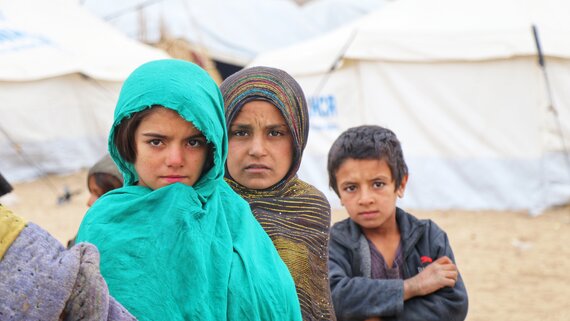
Dand, Afghanistan
The 6,000 IDPs in Dand are some of the tens of thousands of people displaced from southern Afghanistan, forced to flee conflict in October last year. Many were farmers who were able to support themselves and their families before. But when they fled, they left behind their homes, land and livestock. Now they are internally displaced and living in tents with no access to their livelihoods.
OCHA/Fariba HousainiLimited humanitarian funding in previous years had driven a prioritization of low-cost and higher reach activities. People were reached with some form of assistance, but overall vulnerabilities did not improve. As a result, several sectors have revised their assistance modalities to increase volume and duration or include more comprehensive packages that more appropriately match the depth of people’s vulnerabilities and are more cost-effective in the long term. The response will also continue to emphasize the need to expand work on accountability to affected populations, reinforce the importance of protection from sexual exploitation and abuse, and strengthen gender, mental health and disability inclusion.
Achievements and innovations
Since 2020, the humanitarian community has made considerable progress in enhancing vulnerability-focused response, and it has improved analysis of chronic needs requiring social assistance to avert slippage into life-threatening categories. This year, humanitarians made an honest evaluation of the impact of past assistance on people’s living conditions. This showed that while assistance had offered an immediate lifeline, it was not sufficient to cover people’s basic needs.
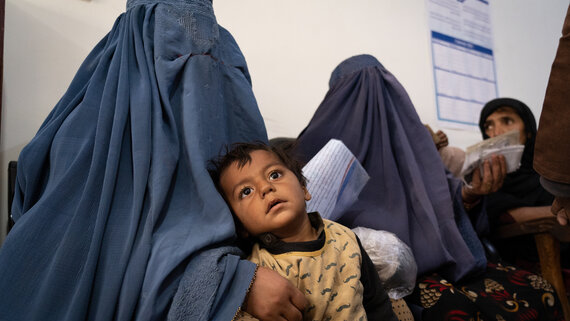
Jalalabad, Afghanistan
A child and his mother wait at a cash distribution organized by an NGO in Jalalabad Province.
OCHA/Charlotte CansAs a result, humanitarians have revised the volume, duration and quality of core assistance packages commensurate to deepened vulnerabilities. The response will also modestly increase the range of costlier packages – such as shelter and water system repairs – which remain life-saving, offer medium-term relief and are cost-effective in the long run, by reducing future needs.
Further reading
Source: OCHA
Source: Humanitarian Insight
Source: Financial Tracking Service
Myanmar
Analysis of the context, crisis and needs
The people of Myanmar are facing an unprecedented political, human rights and humanitarian crisis, with needs escalating dramatically since the military takeover and a severe COVID-19 third wave in 2021. This has generated new needs in new areas with increased displacement due to the spread of conflict. The military takeover and the large-scale civil disobedience movement that followed have heavily impacted the already fragile public service sector, further restricting the access of people in need to basic services. The twin crises of COVID-19 and the military takeover have also deepened pre-existing needs among already vulnerable groups, including stateless Rohingya people and protracted IDPs in the country’s north-east. New needs have also been identified as a result of the new national frame of analysis that uses food insecurity as a measure to vulnerability.

Yangon, Myanmar
A family have lunch at their home in an informal settlement in Hlaingtharyar Township, Yangon. A combination of the pandemic and civil unrest, following the February 2021 military takeover is pushing Myanmar’s economy and the most vulnerable people into financial distress and worsening food insecurity. Food prices are increasing and food availability is becoming limited in conflict-affected areas.
WFP/Kaung Htet LinnThe economic and political turmoil of 2021 has combined to drive almost half the population into poverty, wiping out gains made since 2005. Increasing numbers of vulnerable people are exhausting their coping capacity and are now slipping into humanitarian need. Price hikes, COVID-19 movement restrictions and ongoing insecurity have forced the most vulnerable people to resort to crisis or emergency coping mechanisms to access food and basic services. Prices for key household commodities have increased significantly, making food unaffordable for many. Monsoon floods in July and August 2021 hit communities already in need of humanitarian assistance in various parts of the country, resulting in loss of crops and increased food insecurity. This multidimensional humanitarian crisis is now affecting the whole country, posing grave protection risks for civilians, limiting access to services and deepening food insecurity. This requires a broader national needs analysis and a scaled-up humanitarian response to stop people slipping into life-threatening need.
Projected situation in 2022 and beyond
The political, socioeconomic and protection crisis in Myanmar is fuelling growing humanitarian needs. The outlook for 2022 remains dire, with the key drivers of need – conflict, COVID-19, economic stress and statelessness – all continuing to negatively affect the population. The political and security situation is expected to remain volatile, with increased displacement anticipated. The devastating third wave of COVID-19 appears to be breaking as 2021 draws to a close. However, a damaging fourth wave due to low vaccination rates is a significant risk in 2022. Associated COVID-19 precautions and restrictions are likely to be a continuing factor for the people of Myanmar and the response in 2022. The general trend of price hikes of basic food items and agricultural inputs is expected to continue, reducing food affordability.
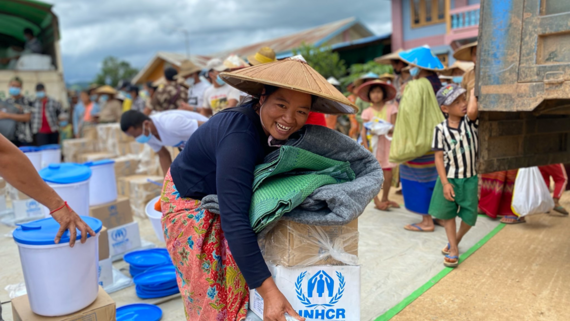
Shan State, Myanmar
A woman at an aid distribution point in Myanmar’s Shan State, where people receive relief items.
Relief InternationalWomen, children and people with disability are particularly vulnerable amid this economic and protection crisis, exposing them to risks of exploitation and abuse, including sexual and gender-based violence. Learning has been disrupted for almost 12 million children due to widespread COVID-19 school closures. Needs that were unmet in 2020 and 2021 because of access constraints have directly contributed to escalating needs heading into next year.
The expanded nature of the crisis has prompted the Humanitarian Country Team to apply a wider national vulnerability lens to the needs analysis. In the absence of national multisectoral needs assessments, food insecurity data was mostly used as a proxy basis for determining intersectoral vulnerability. The joint intersectoral analysis process identified 14.4 million people in humanitarian need in Myanmar in 2022. It is important to note that figures for 2022 are not comparable to previous years due to the change in scope and methodology.
Response priorities in 2022
After a significant scale-up to respond to new needs after the military takeover, the humanitarian community expects to have reached 2.2 million people out of 3 million targeted for assistance by the end of 2021. This wider reach is predominantly the result of increased food distributions in new conflict areas and urban locations. Humanitarian organizations stand ready to further step up their efforts and have set an ambitious target of assisting 6.2 million people in 2022. Humanitarian partners require US$826 million to support this more ambitious programme covering new people in new areas. The financial ask is more than double the requirement in 2021. This is a reflection of deeper needs being observed, a wider response being planned, inflation and increased cost of delivery.
Myanmar HRP
The focus of the 2022 response will be to save lives and improve the overall health and mental and physical well-being of people affected by COVID-19, conflict and natural disasters through timely and integrated assistance. Vulnerable people’s living standards will be improved and their resilience strengthened. Partners will work to ensure that protection risks are mitigated, protection needs are monitored and met, and respect for international humanitarian law is promoted. Targeting will be continuously reviewed and refined with the possibility of a further revision in the first half of 2022.
The expanded response will require improved access and reduced red tape. Access to affected people for the delivery of assistance and people’s access to life-saving services and support remains limited in many parts of the country, with constraints being most severe in areas of active conflict where there is now a heavy reliance on support from local and national partners. Staff safety in these areas is a serious concern due to active fighting, landmines, intimidation and threats. Bureaucratic impediments are also affecting the pace and effectiveness of the response, and COVID-19 movement restrictions have limited access.
Further reading
Source: Office for the Coordination of Humanitarian Affairs
Source: Humanitarian Insight
Source: Financial Tracking Service
References
- UNHCR, Operational Data Portal, as of 30 June 2021
- 2022 requirements are provisional
- Reach Initiative (June 2020). Winterization Evaluation (an evaluation of the winter assistance in 2019-2020).

